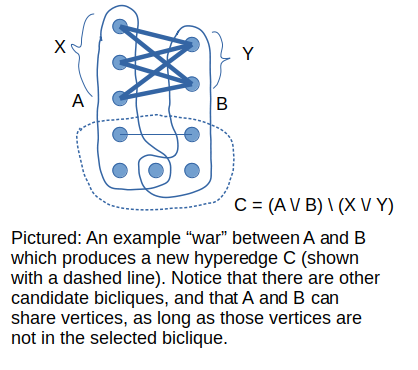Apologies for the vague title. This decision problem has applications to graph coloring but I have not found a name for it in the literature.
I am trying to improve my algorithm for a decision problem. The problem input is a graph and hypergraph which have the same vertex set, $(V, E, H)$ where $V$ is the set of vertices, $E$ is the set of edges, and $H$ is the set of hyperedges.
The Hostile Soldiers and Alliances Game
Imagine there is a set of soldiers (vertices) such that for every pair of soldiers, either:
- The two soldiers are hostile towards each other (there is an edge between them), or
- They are indifferent towards each other (there is not an edge between them)
The soldiers can also be involved in a set of alliances (hyperedges).
Two alliances $A$ and $B$ can go to war if there exists:
- some nonempty set of soldiers $X \subseteq A \setminus B$, and
- some nonempty set of soldiers $Y \subseteq B \setminus A$
such that every soldier in $X$ is hostile to every soldier in $Y$, i.e., $X$ and $Y$ form a biclique.
The war results in a new alliance made up of all the soldiers who did not participate in the hostile biclique, $(A \cup B) \setminus (X \cup Y)$. An alliance cannot go to war with itself.
Now imagine that your goal is to come up with a sequence of wars (biclique, hyperedge, hyperedge) such that the last war produces an alliance with zero members. Each edge in $E$ can be used at most once in the sequence of wars.
Pictured is an example
This problem is in NP, since a proof certificate can have at most $|E|$ bicliques. I suspect that this problem is NP-complete but I have not found a reduction yet.
My algorithm attempt
function decide(graph, hypergraph) -> bool:
for each pair of hyperedges A, B in hypergraph:
for each biclique X, Y in A, B:
C = (A \/ B) - (X \/ Y)
if C is empty:
return True
if decide(graph - biclique, hypergraph + C):
return True
return False
I am not sure of the time complexity of this algorithm, but since it is brute-force looking for a sequence of wars, I would not be surprised if it is factorial in the number of bicliques (which itself is exponential in the number of vertices).
I have not seen a case yet where a solution requires that a hyperedge is used twice in the sequence of wars. I haven't been able to prove it, but if so, then I could change the algorithm to recur on (graph - biclique, (hypergraph + C) - (A + B)), that is, the algorithm could eliminate $A$ and $B$ from the search after using them in a war.
Are there any opportunities for improving this algorithm?


